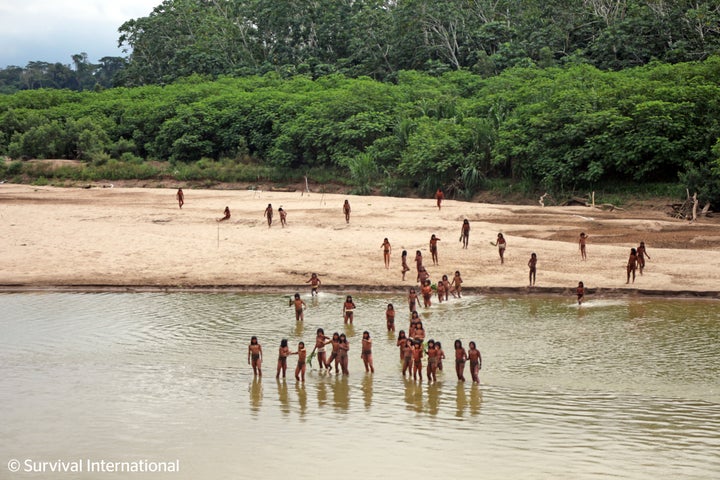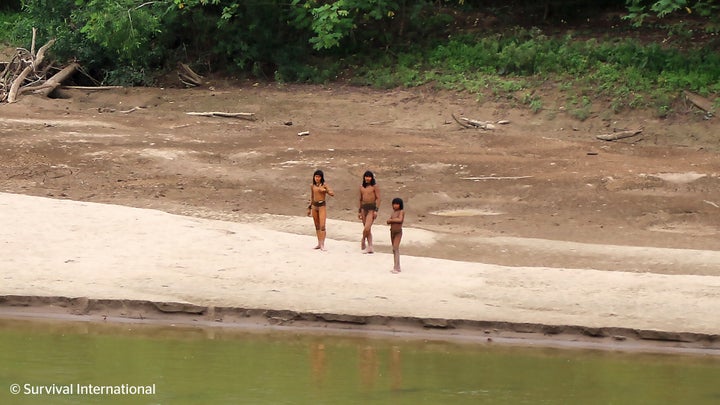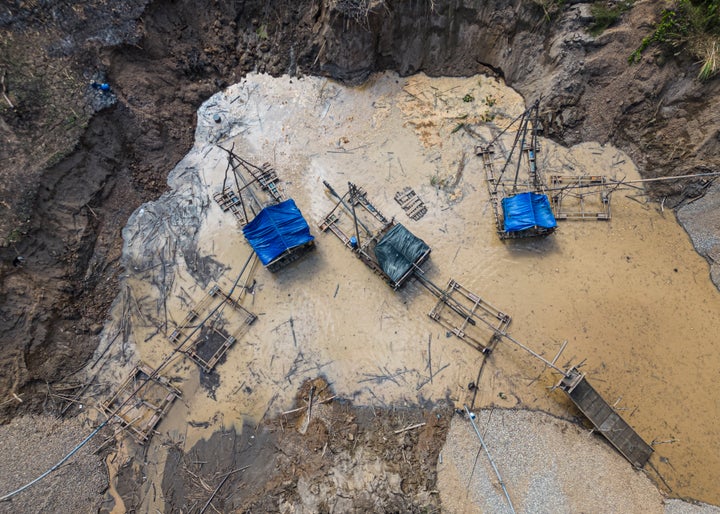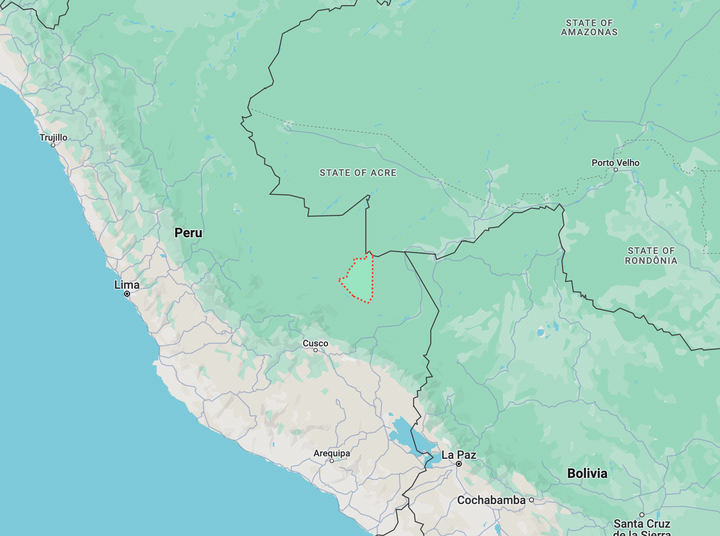Rare photos and video published this week show members of an isolated Indigenous South American tribe emerging from the Amazonian rainforest in Peru near where logging companies have been demolishing land under government-backed concessions.
More than 50 members of the Mashco Piro tribe were seen on June 26 near the Yine village of Monte Salvado, close to the borders of Brazil and Bolivia in Madre de Dios, a representative with Survival International, which published the footage Tuesday, told HuffPost.
“Several logging companies hold timber concessions inside the territory that belongs to the Mashco Piro people,” the Indigenous rights organization said in a release. “The nearest is just a few miles from where the Mashco Piro were filmed.”

The Mashco Piro have had no contact with people from outside the area, and are considered voluntarily isolated. They have angrily denounced the presence of the loggers on their land, Survival International said, citing the Yine, who speak a language similar to that of the Mashco Piro.
Survival International director Caroline Pearce called the loggers’ presence on the land “a humanitarian disaster in the making.”
“It’s absolutely vital that the loggers are thrown out, and the Mashco Piro’s territory is properly protected at last,” she said in a statement.
Alejandro Parellada, a senior adviser with the International Work Group on Indigenous Affairs whose work focuses on Indigenous people’s land rights in Latin America, said that these sightings along Peru’s beaches and rivers are occurring in part because of recent land changes by outsiders.

“It has happened several times in recent years because the forest areas where these peoples live have been invaded by loggers, illegal miners, etc.,” he told HuffPost in an email Thursday. “This is a situation that IWGIA has been studying and reporting on for 30 years.”
A 2013 report released by the IWGIA with the Inter-American Commission on Human Rights estimated that there are hundreds or thousands of Indigenous people living in the Americas with voluntary isolation, or with only some initial contact, and that they occupy more than 9 million hectares with different levels of protection afforded to them.
These kinds of communities face numerous risks that have contributed to their decline and in many cases total elimination, including loss of land and resources, the risk of infectious diseases, and negative psychological effects from contact with outsiders.
“According to the National Environment Commission of Peru, from 1950 to 1957, a total of 11 indigenous peoples disappeared from the Amazon, and of the peoples remaining, 18 are in grave danger of disappearing, as they each have fewer than 225 persons,” the IWGIA’s report found.

The report cited the case of the Mashco Piro people as an example of the harmful pressures being placed on Indigenous land territories. It pointed to river sightings of the people in 2011 and 2013 in Madre de Dios’ Tahuamanu province as warning signs.
“Although the reason for the appearance of the members of this people in such a visible area is not known, some hypotheses indicate that it may be due to the pressure of logging and oil and gas activities in the area, internal splits within the people, or the attraction to metal objects in neighboring communities,” the report said.
Parellada said his group has been working for years to help protect land for these people and others.
“Our organization worked in the 1990s to create protected areas for the different peoples in isolation and initial contact. Since then, several large protected areas have been created (initially with the support of IWGIA and later from other cooperation institutions),” he said.

Alfredo Vargas Pio ― president of Federación Nativa del Río Madre de Dios y Afluentes, a local Indigenous rights group ― said these new photos and video show that more work is needed.
“This is irrefutable evidence that many Mashco Piro live in this area, which the government has not only failed to protect, but actually sold off to logging companies,” he said in a statement shared by Survival International.
Survival International called for one logging company operating near the people, Maderera Canales Tahuamanu, to lose its certification with the Forest Stewardship Council. That certification labels the company as operating sustainably and ethically. The company has approximately 53,000 hectares of certified forest area in the Madre de Dios region, according to the FSC’s website.
The FSC, responding to Survival International’s criticisms in a statement Wednesday, said the operations of Maderera Canales Tahuamanu have been determined to be legal and in an area declared “a forest of permanent production” by Peru’s government. It said it will review the company’s compliance “with duties to respect and protect the rights of Indigenous Peoples.”

“The company has protocols in place to avoid encounters with members of the Mashco Piro, designed in coordination with the Ministry of Culture in Peru which is responsible for protecting Indigenous Peoples living in voluntary isolation,” the FSC said.
More than 45% of the Madre de Dios territory (3.8 million hectares) is labeled as a protected wildlife area. More than 15% of the remaining land (1.3 million hectares) is zoned for timber concessions, of which about 600,400 hectares are FSC-certified, according to a 2021 report by the United States Agency for International Development and the Norwegian Agency for Development Cooperation.
The Madre de Dios’ province of Tahuamanu holds the highest number of certified forests in all of Peru. At least four logging companies operate there with voluntary forest certification.
“Certified companies undergo annual evaluations and audits to maintain a standard of good management practices, including compliance with forestry legislation [and] actions to prevent social conflicts and threats, including the control of illegality,” the USAID and NORAD report says.

